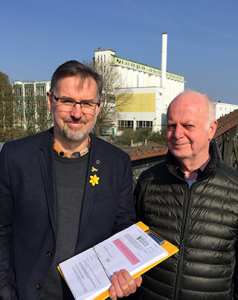Lib Dems vow to hold the Council and Spenhill to account on Phase 2

Cllr Malcolm Cowan and Nigel Quinton
Last Thursday, 30th April, Welwyn Hatfield Council gave approval to Spenhill (the property arm of Tesco) to develop the old Shredded Wheat site next to the train station. In many ways this is a cause for celebration – the scheme is for high quality urban architecture in a strategic position in the town centre that will provide 850 new homes and will extend the retail and evening economies into Peartree Ward. The developer will also fund £4M of highways work and £3.5M towards educational needs, mostly towards a new, larger, Peartree School, which we very much welcome.
However, in one very important respect the scheme is hopelessly deficient. Only 50 of the 850 homes (less than 6%) are to be affordable homes, despite the Council’s own policy that at least 30% of homes in this development should be affordable. That it was as many as 50 is only because pressure in the past week from our comments in the press has forced the issue. Only in the eleventh hour, on the day before approval, was the number of affordable homes increased from 35 to 50.
The developer was allowed to get away with this by convincing the Council that the scheme was ‘not viable’ if affordable housing was included. The committee accepted the advice of officers on this point, despite it being pointed out that the advice from the Council’s own advisors, Colliers International, was that the scheme was viable with or without affordable housing. In fact the scheme is forecast to generate profits of at least £86M, and probably a lot more.
Nigel Quinton, who is standing for election in the County Division that includes the site, and who spoke to the committee last night to stress the case for more affordable housing, had this to say:
“Whilst I very much want this development to go ahead, it absolutely has to include 30% affordable homes, and I am disappointed that the Council has given in on this point when the case on viability has not been made. The additional 15 affordable homes announced at the meeting are welcome, but are not enough.
“The silver lining, and one that the Council and committee are clearly clinging to, is that the scheme has two phases, the first is for 350 homes, the second for 500, and Spenhill still need final approval for the second. At that stage they have to demonstrate the lack of viability all over again. If they cannot, then we believe that they would have to make the affordable component up to the full 30% of the total.
“We intend to make sure Spenhill, and the Council, do not shun their responsibility to provide the affordable homes our town so desperately needs.
“There are other issues that we will continue to press the Council to address – the lack of communication with Network Rail about the rail bridge and the potential impact of the new restaurants and bars on the remainder of the Town Centre economy. Also, while we welcome the inclusion of some community and leisure facilities in the scheme it is some way short of the Swimming Pool we had campaigned for and which was included in the Planning Guidance and which the Town still lacks – this site has the capacity to deliver huge profits for the developer, and the Council should be ensuring a greater amount of benefit to the community.”
 17,170 pensioners living in Welwyn Hatfield will receive at least an extra £772 per year under Liberal Democrat manifesto plans to protect the ‘triple lock’ for state pensions.
17,170 pensioners living in Welwyn Hatfield will receive at least an extra £772 per year under Liberal Democrat manifesto plans to protect the ‘triple lock’ for state pensions.
